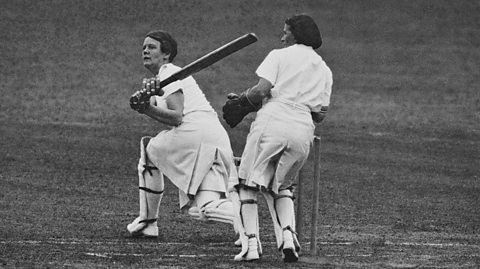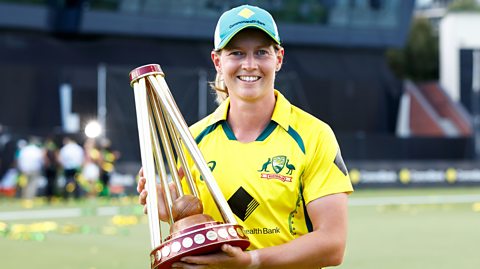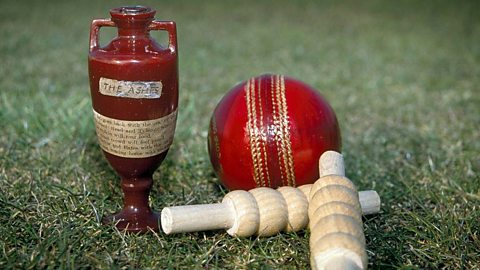The Women’s Ashes is a international cricket series that takes place every two years between England and Australia.
The first women’s series began in 1934, 52 years after the first men’s tournament, and is now recognised as one of the most prestigious titles in cricket. But how did this sporting rivalry begin?
±«Óătv Bitesize takes a look at the story behind the Women’s Ashes, but first – here’s a quick guide to some popular cricket words.

Cricket vocabulary
Inning: A period in a game of cricket during which a particular team or player is batting.
Over: When a player from the fielding team bowls six legitimate deliveries to a batsman on the opposing team.
Run: A run is a unit of scoring. One run is scored each time the batsmen cross and reach the set of stumps at the other end of the pitch.
Test: A match consisting of two innings per team which is played for up to five days.
Wicket: A wicket is a set of three stumps with two wooden bails on top of them. They can be stumped, hit, kept, taken or given away.
Find out more: Where does cricket jargon like wicket, yorker and sledging come from?

Women's cricket: The early history
While the Women’s Ashes wasn’t officiated until 1998, women have been playing cricket for centuries. In fact, the first recorded women’s match took place in Surrey in 1745 and, from there, the game grew increasingly popular over the years. Between 1890 and 1918 over 140 women’s clubs were formed in Britain - though many clubs were disbanded during World War One.
The Ashes history between England and Australia began in the women’s Tests in 1934, but a trophy was never created for the series. This was a rule mandated by the English Women’s Cricket Association (WCA), whose original constitution in 1930 stated that "no member of any affiliated club shall take part in any cricket challenge cup or prize competition".
For some trophies weren’t a priority. Betty Archdale, the first captain of the England team stressed that, “We are not here for any Ashes but merely to play cricket” when she arrived in Australia to play the team for the first time in 1934.
The inaugural Ashes was coordinated by the Australian Women's Cricket Council (AWCC), with Tests in grounds across Brisbane, Sydney and Melbourne. The 27 players, of which 15 played for Australia and 12 played for England, spent hours on the pitch with many challenging runs and wickets along the way.
England won the First and Second Test, by nine and eight wickets respectively, while the Third Test resulted in a draw. This led to England taking home the title in January 1935.

The origins of the Women’s Ashes trophy
Over the years demand for an Ashes trophy began to grow. In 1998 the Women’s Cricket Association (WCA), the body which governed women’s cricket in Britain for 72 years, merged with the newly created England and Wales Cricket Board. This unified board would oversee both men’s and women’s cricket - the second to align its men’s and women’s teams after New Zealand’s.
The President of the WCA and former England women’s manager Norma Izard OBE dreamed up and designed the Ashes trophy. She commissioned a woodcarver to create a hollow cricket ball, using wood from a 300 year old yew tree. Before the First Test, Izard obtained a miniature cricket bat and a large wok from the Lord’s Cricket Ground kitchens. Signatures from both sets of players and a copy of the WCA constitution were burnt and added to the kindling.
A ceremony took place in the Harris Garden inside Lord’s Cricket Ground and was attended by 30 people. The ashes were then gathered up and placed into the trophy. This moment would turn out to be one of the most significant events in the history of women’s cricket.
The first official Women's Ashes was held the following day - and it didn’t disappoint. Australia women's captain Belinda Clark led her team to victory over England after the fifth and finalOne Day International (ODI) is a form of cricket played between two teams with international status, with 50 overs per side., completing a series A term used in cricket that refers to a team that has won all played matches in a series.. However, the ODI series was followed by three Tests, which all ended in a draw. This meant that the first Women’s Ashes trophy was shared.

Looking to the Women’s Ashes 2023
Since the 1934-35 season, Australia hold the Ashes record with a total of 10 wins out of 22 series. By comparison England have won six and the teams have drawn equal eight times.
Australia’s Ellyse Perry is the one to beat when it comes to Ashes cricket records. In 2022, she secured the all-time Ashes record for most runs at 1552, as well as the most wickets at 68.
But who will lift the trophy this year?
The women’s 2023 contest will start on 16 June and begin with a rare five-day Test match at Trent Brent. The multi-format series consists of one Test match (worth four points), three ODIs and three A variant of cricket where each team is allowed one innings to try and score as many runs they can within a period of 20 overs. (each worth two points).
It marks the first year that the men’s and women’s Ashes are being played alongside one another on a joint platform and without any fixture clashes. By May 2023, ticket sales record for England women’s fixtures was broken, with 70,000 tickets already sold - compared to 32,000 tickets sold in 2019.
This article was published in June 2023
Origins of cricket jargon
What do ducks have to do with cricket? Find out here.

From Tests to The Hundred: A bluffer’s guide to cricket’s formats
How one of the oldest sports in the world kept up with the times.

Cricket and cremation: The fascinating history of the Ashes
The story of the tiny urn which represents a lengthy England-Australia rivalry.
